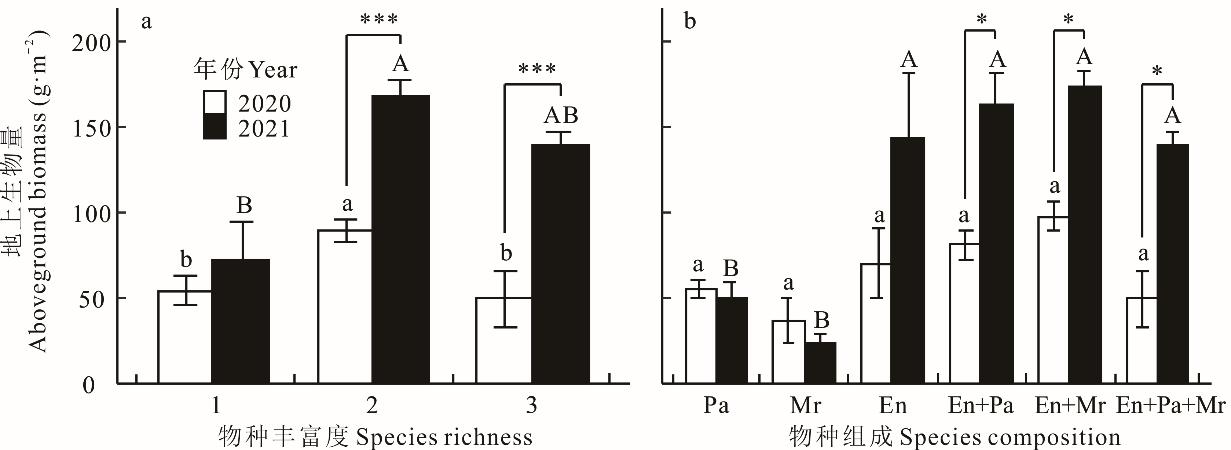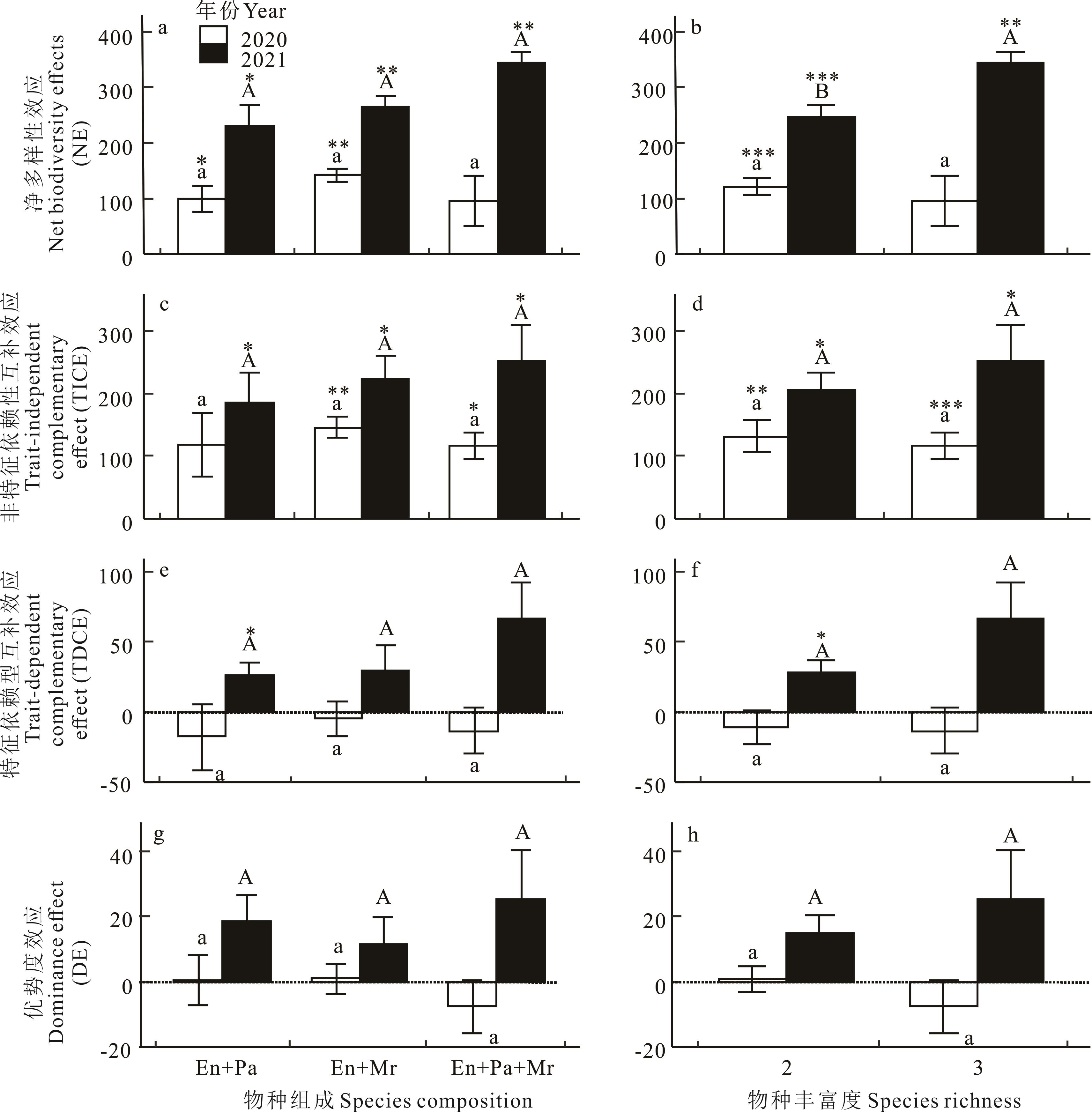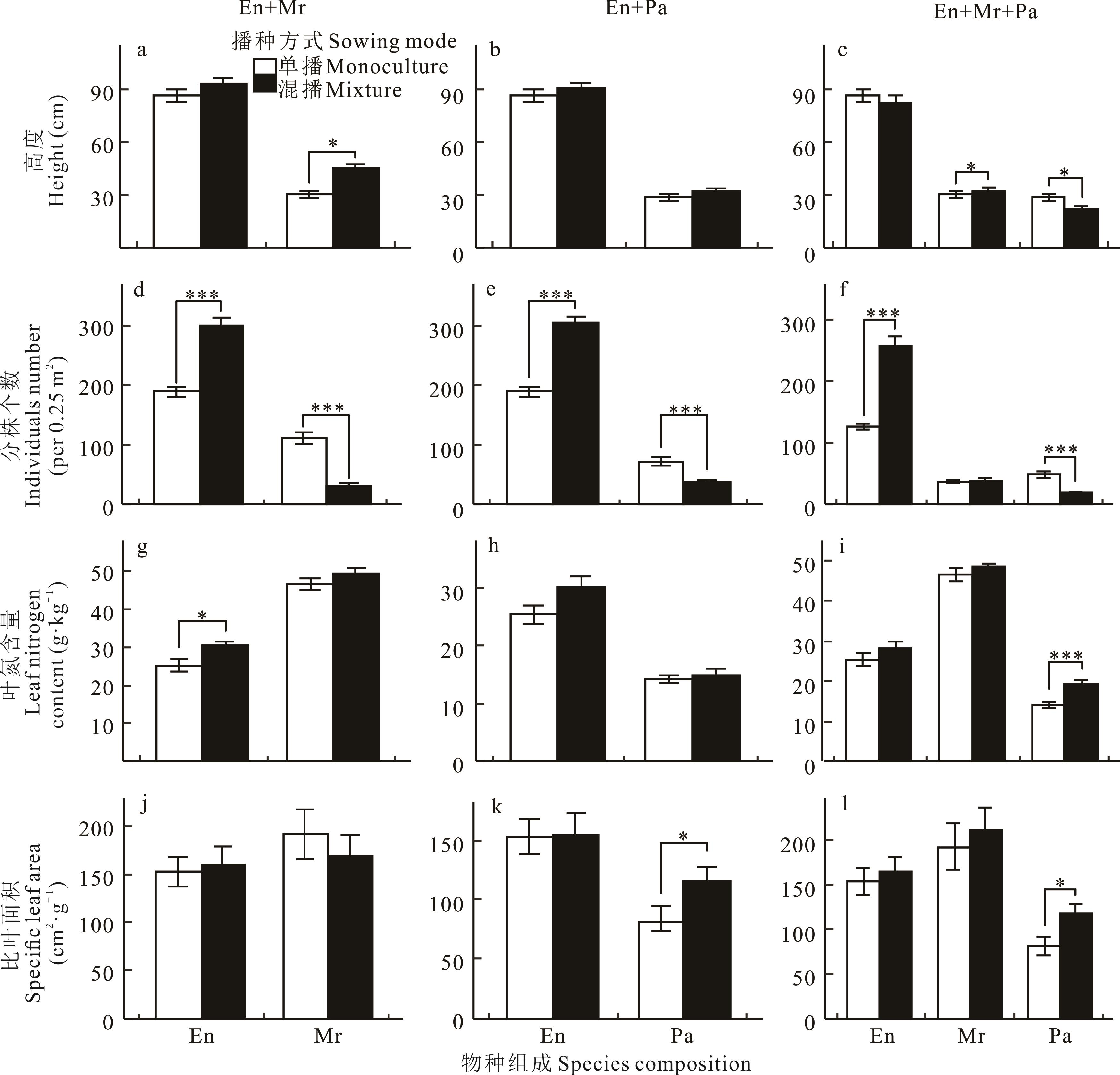

ISSN 1004-5759 CN 62-1105/S


草业学报 ›› 2023, Vol. 32 ›› Issue (9): 27-38.DOI: 10.11686/cyxb2022446
刘增辉1( ), 卢素锦1, 王雨欣1, 张春辉2, 尹鑫1(
), 卢素锦1, 王雨欣1, 张春辉2, 尹鑫1( )
)
收稿日期:2022-11-10
修回日期:2023-01-04
出版日期:2023-09-20
发布日期:2023-07-12
通讯作者:
尹鑫
作者简介:E-mail: yinx18@163.com基金资助:
Zeng-hui LIU1( ), Su-jin LU1, Yu-xin WANG1, Chun-hui ZHANG2, Xin YIN1(
), Su-jin LU1, Yu-xin WANG1, Chun-hui ZHANG2, Xin YIN1( )
)
Received:2022-11-10
Revised:2023-01-04
Online:2023-09-20
Published:2023-07-12
Contact:
Xin YIN
摘要:
克隆植物具有独特的竞争和繁殖方式,这可能会使其构建的群落呈现不一样的生物多样性-生态系统功能关系,但是本议题却极少被研究。本研究利用垂穗披碱草、花苜蓿和鹅绒委陵菜构建了一个生物多样性试验,并将单播和混播重复3次,且将垂穗披碱草作为所有混播的固定物种,以此跨越两个生长季测试生物多样性对生产力的影响。本研究发现,物种丰富度和地上生物量之间并没有线性正相关关系,但是大多数混播的净多样性效应(NE)都是显著的,且NE主要来源于非特征依赖性互补效应(TICE)。较强的TICE主要来自地上垂直空间的互补性利用;其次来自底层物种鹅绒委陵菜光吸收能力的增强。沿着时间和物种丰富度梯度,垂穗披碱草的优势度增强,鹅绒委陵菜的优势度下降,致使特征依赖型互补效应(TDCE)和优势度效应(DE)随之增强,但是它们对NE的贡献有限。另外,以上3种效应均随时间增强。总之,本研究的结果表明克隆植物群落表现出了不一样的多样性-生产力关系模式,并且这种多样性效应主要来自地上垂直空间的互补性利用。
刘增辉, 卢素锦, 王雨欣, 张春辉, 尹鑫. 三江源地区人工克隆植物群落生物多样性对初级生产力的影响及机制[J]. 草业学报, 2023, 32(9): 27-38.
Zeng-hui LIU, Su-jin LU, Yu-xin WANG, Chun-hui ZHANG, Xin YIN. Effects of biodiversity on primary productivity and its mechanism in artificially sown clonal plant communities of the Sanjiangyuan region[J]. Acta Prataculturae Sinica, 2023, 32(9): 27-38.

图1 物种丰富度和物种组成对克隆植物群落生物量的影响不同小写字母表示试验第一年不同物种丰富度或物种组成间差异显著,不同大写字母表示试验第二年不同物种丰富度或物种组成间差异显著。星号表示不同年份间同一物种丰富度或物种组成间差异显著(*: P<0.05; ***: P<0.001)。以上标注均由相应的数据进行单因素方差分析及多重比较得到。Different lowercase letters indicate significant differences among different species richness or species composition in first year of the experiment, different capital letters indicate significant differences among different species richness or species composition in second year of the experiment. Asterisk indicates significant differences with the same species richness or species composition between years (*: P<0.05; ***: P<0.001). All the above annotations are obtained by one-way ANOVA and multiple comparisons of the corresponding data. Pa: 鹅绒委陵菜P. anserine; Mr: 花苜蓿M. ruthenica; En: 垂穗披碱草E. nutans. 下同The same below.
Fig.1 The effects of species composition and species richness on aboveground biomass in clonal plant community
处理 Treatment | df | NE | TICE | TDCE | DE | ||||
|---|---|---|---|---|---|---|---|---|---|
| F | P | F | P | F | P | F | P | ||
| 物种丰富度Species richness | 1,14 | 2.058 | 0.1734 | 0.215 | 0.6497 | 1.583 | 0.22890 | 0.018 | 0.8945 |
| 年份Year | 1,14 | 51.592 | <0.0010 | 8.521 | 0.0112 | 14.385 | 0.00198 | 8.652 | 0.0107 |
| 丰富度×年份Species richness×year | 1,14 | 6.057 | 0.0274 | 0.822 | 0.3798 | 1.934 | 0.18607 | 1.575 | 0.2300 |
表1 物种丰富度和年份对NE、TICE、TDCE、DE的影响
Table 1 The effects of species richness and year on NE, TICE, TDCE and DE
处理 Treatment | df | NE | TICE | TDCE | DE | ||||
|---|---|---|---|---|---|---|---|---|---|
| F | P | F | P | F | P | F | P | ||
| 物种丰富度Species richness | 1,14 | 2.058 | 0.1734 | 0.215 | 0.6497 | 1.583 | 0.22890 | 0.018 | 0.8945 |
| 年份Year | 1,14 | 51.592 | <0.0010 | 8.521 | 0.0112 | 14.385 | 0.00198 | 8.652 | 0.0107 |
| 丰富度×年份Species richness×year | 1,14 | 6.057 | 0.0274 | 0.822 | 0.3798 | 1.934 | 0.18607 | 1.575 | 0.2300 |
处理 Treatment | df | NE | TICE | TDCE | DE | ||||
|---|---|---|---|---|---|---|---|---|---|
| F | P | F | P | F | P | F | P | ||
| 物种组成Species composition | 1,14 | 1.867 | 0.197 | 0.416 | 0.6688 | 0.789 | 0.476 | 0.075 | 0.9286 |
| 年份Year | 1,14 | 50.607 | <0.001 | 7.700 | 0.0168 | 12.602 | 0.004 | 7.602 | 0.0174 |
| 物种组成×年份Species composition×year | 1,14 | 2.980 | 0.089 | 0.378 | 0.6929 | 0.883 | 0.439 | 0.776 | 0.4819 |
表2 物种组成和年份对NE、TICE、TDCE、DE的影响
Table 2 The effects of species composition and year on NE, TICE, TDCE and DE
处理 Treatment | df | NE | TICE | TDCE | DE | ||||
|---|---|---|---|---|---|---|---|---|---|
| F | P | F | P | F | P | F | P | ||
| 物种组成Species composition | 1,14 | 1.867 | 0.197 | 0.416 | 0.6688 | 0.789 | 0.476 | 0.075 | 0.9286 |
| 年份Year | 1,14 | 50.607 | <0.001 | 7.700 | 0.0168 | 12.602 | 0.004 | 7.602 | 0.0174 |
| 物种组成×年份Species composition×year | 1,14 | 2.980 | 0.089 | 0.378 | 0.6929 | 0.883 | 0.439 | 0.776 | 0.4819 |

图2 物种丰富度或物种组成在不同年份内分别对净多样性效应、非特征依赖性互补效应、特征依赖型互补效应和优势度效应的影响星号表示几种效应与0有显著差异(*: P<0.05; **: P<0.01; ***: P<0.001)。 Asterisk indicates significant differences between different effects and 0 (*: P<0.05; **: P<0.01; ***: P<0.001).
Fig.2 The effects of species richness or species composition on net biodiversity effects (NE), trait-independent complementary effects (TICE), trait-dependent complementary effects (TDCE) and dominance effects (DE) in different years

图3 混播群落中各物种地上生物量的自然对数响应比(LNRR)在不同年份的表现星号表示LNRR显著大于或小于0(*: P<0.05)。Asterisk indicates LNRR is significant greater or less than 0 (*: P<0.05).
Fig.3 The values of natural logarithm response ratio (LNRR) of aboveground biomass about different species in all mixture of different years

图4 不同播种方式(单播和混播)对植物性状的影响星号表示不同植物性状在播种方式间的差异显著(*: P<0.05; ***: P<0.001)。Asterisk indicates difference of plant traits are significant under different sowing mode (*: P<0.05; ***: P<0.001).
Fig.4 The effects of same plant species under different sowing mode (single and mixed sowing) on plant traits
| 1 | Mori A S, Dee L E, Gonzalez A, et al. Biodiversity-productivity relationships are key to nature-based climate solutions. Nature Climate Change, 2021, 11(7): 543-550. |
| 2 | He M, Pan Y, Zhou G, et al. Grazing and global change factors differentially affect biodiversity-ecosystem functioning relationships in grassland ecosystems. Global Change Biology, 2022, 28(18): 5492-5504. |
| 3 | Xi N, Chen D, Bahn M, et al. Drought soil legacy alters drivers of plant diversity-productivity relationships in old-field systems. Science Advances, 2022, 8(18): 1-11. |
| 4 | Tilman D. The ecological consequences of changes in biodiversity: A search for general principles. Ecology, 1999, 80(5): 1455-1474. |
| 5 | Isbell F, Balvanera P, Mori A S, et al. Expert perspectives on global biodiversity loss and its drivers and impacts on people. Frontiers in Ecology and the Environment, 2022, 22(1): 1-10. |
| 6 | Grime J P. Competition exclusion in herbaceous vegetation. Nature, 1973, 242: 344-347. |
| 7 | Gillman L N, Wright S D. The influence of productivity on the species richness of plants: A critical assessment. Ecology, 2006, 87(5): 1234-1243. |
| 8 | Van R J, Berendse F. Diversity-productivity relationships: Initial effects, long-term patterns, and underlying mechanisms. Proceedings of the National Academy of Sciences of the United States of America, 2005, 102(3): 695-700. |
| 9 | Roscher C, Schumacher J. Positive diversity effects on productivity in mixtures of arable weed species as related to density-size relationships. Journal of Plant Ecology, 2016, 9(6): 792-804. |
| 10 | Cheng Y, Zhang C, Zhao X, et al. Biomass-dominant species shape the productivity-diversity relationship in two temperate forests. Annals of Forest Science, 2018, 75(4): 97-106. |
| 11 | Chanteloup P, Bonis A. Functional diversity in root and above-ground traits in a fertile grassland shows a detrimental effect on productivity. Basic and Applied Ecology, 2013, 14(3): 208-216. |
| 12 | Waide R B, Willig M R, Steiner C F, et al. The relationship between productivity and species richness. Annual Review of Ecology and Systematics, 1999, 30: 257-300. |
| 13 | Šímová I, Li Y M, Storch D. Relationship between species richness and productivity in plants: The role of sampling effect, heterogeneity and species pool. Journal of Ecology, 2013, 101(1): 161-170. |
| 14 | Lisner A, Ottaviani G, Klimešová J, et al. The species richness-productivity relationship varies among regions and productivity estimates, but not with spatial resolution. Oikos, 2021, 130(10): 1704-1714. |
| 15 | Long Z T, Bruno J F, Duffy J E. Biodiversity mediates productivity through different mechanisms at adjacent trophic levels. Ecology, 2007, 88(11): 2821-2829. |
| 16 | Liu J J, Xu Y, Shan Y X, et al. Biotic and abiotic factors determine species diversity-productivity relationships in mountain meadows. Journal of Plant Ecology, 2021, 14(6): 1175-1188. |
| 17 | Hillebrand H, Blasius B, Borer E T, et al. Biodiversity change is uncoupled from species richness trends: Consequences for conservation and monitoring. Journal of Applied Ecology, 2018, 55(1): 169-184. |
| 18 | Spaak J W, Baert J M, Baird D J, et al. Shifts of community composition and population density substantially affect ecosystem function despite invariant richness. Ecology Letters, 2017, 20: 1315-1324. |
| 19 | Zhang R, Schellenberg M P, Tian D, et al. Shifting community composition determines the biodiversity-productivity relationship under increasing precipitation and N deposition. Journal of Vegetation Science, 2021, 32(2): e12998. |
| 20 | Mahaut L, Fort F, Violle C, et al. Multiple facets of diversity effects on plant productivity: Species richness, functional diversity, species identity and intraspecific competition. Functional Ecology, 2020, 34(1): 287-298. |
| 21 | Calatayud M L, Forrestel E J, Chang C C, et al. Demystifying dominant species. New Phytologist, 2019, 223(3): 1106-1126. |
| 22 | Calatayud J, Andivia E, Escudero A, et al. Positive associations among rare species and their persistence in ecological assemblages. Nature Ecology & Evolution, 2020, 4(1): 40-45. |
| 23 | Creed R P, Cherry R P, Pflaum J R, et al. Dominant species can produce a negative relationship between species diversity and ecosystem function. Oikos, 2009, 118(5): 723-732. |
| 24 | O’Connor N E, Crowe T P. Biodiversity loss and ecosystem functioning: Distinguishing between number and identity of species. Ecology, 2005, 86(7): 1783-1796. |
| 25 | Liancourt P D, Viard-Crétat F, Michalet R. Contrasting community responses to fertilization and the role of the competitive ability of dominant species. Journal of Vegetation Science, 2009, 20(1): 138-147. |
| 26 | Hooper D U, Chapin F S, Ewel J J, et al. Effects of biodiversity on ecosystem functioning: A consensus of current knowledge. Ecological Monographs, 2005, 75(1): 33-35. |
| 27 | Dong M, Yu F H, Peter A. Ecological consequences of plant clonality. Annals of Botany, 2014, 114(2): 367. |
| 28 | Kang J J, Zhao W Z, Zhao M. Remediation of blowouts by clonal plants in Maqu degraded alpine grasslands of northwest China. Journal of Plant Research, 2017, 130(2): 291-299. |
| 29 | Fu J J, Zhou H K, Zhao X Q, et al. Clonal plants and their importance of different alpine grasslands in Haibei region, Qinghai Province. Acta Agrestia Sinica, 2013, 21(6): 1065-1072. |
| 付京晶, 周华坤, 赵新全, 等. 青海海北不同类型高寒草地的克隆植物及其重要性. 草地学报, 2013, 21(6): 1065-1072. | |
| 30 | Loreau M, Hector A. Partitioning selection and complementarity in biodiversity experiments. Nature, 2001, 412(6842): 72-76. |
| 31 | Fox J W. Interpreting the ‘selection effect’ of biodiversity on ecosystem function. Ecology Letters, 2005, 8(8): 846-856. |
| 32 | Niklaus P A, Baruffol M, He J S, et al. Can niche plasticity promote biodiversity-productivity relationships through increased complementarity? Ecology, 2017, 98(4): 1104-1116. |
| 33 | Dong M. Effects of severing rhizome on clonal growth in rhizomatous grass species Psammochloa villosa and Leymus secalinus. Acta Botanica Sinica, 1999, 41(2): 194-198. |
| 董鸣. 切断根茎对根茎禾草沙鞭和赖草克隆生长的影响. 植物学报, 1999, 41(2): 194-198. | |
| 34 | Wang J, Xu T, Wang Y, et al. A meta-analysis of effects of physiological integration in clonal plants under homogeneous vs. heterogeneous environments. Functional Ecology, 2021, 35(3): 578-589. |
| 35 | Gilbert B, Turkington R, Srivastava D S. Dominant species and diversity: Linking relative abundance to controls of species establishment. The American Naturalist, 2009, 174(6): 850-862. |
| 36 | Saiz H, Bittebiere A K, Benot M L, et al. Understanding clonal plant competition for space over time: A fine-scale spatial approach based on experimental communities. Journal of Vegetation Science, 2016, 27(4): 759-770. |
| 37 | Hodapp D, Hillebrand H, Blasius B, et al. Environmental and trait variability constrain community structure and the biodiversity-productivity relationship. Ecology, 2016, 97(6): 1463-1474. |
| 38 | Marquard E, Weigelt A, Temperton V M, et al. Plant species richness and functional composition drive overyielding in a six-year grassland experiment. Ecology, 2009, 90(12): 3290-3302. |
| 39 | Kraft N J B, Godoy O, Levine J M. Plant functional traits and the multidimensional nature of species coexistence. Proceedings of the National Academy of Sciences of the United States of America, 2015, 112(3): 797-802. |
| 40 | Gubsch M, Buchmann N, Schmid B, et al. Differential effects of plant diversity on functional trait variation of grass species. Annals of Botany, 2011, 107(1): 157-169. |
| 41 | Vojtech E, Loreau M, Yachi S, et al. Light partitioning in experimental grass communities. Oikos, 2008, 117(9): 1351-1361. |
| 42 | Flynn D F B, Mirotchnik N, Jain M, et al. Functional and phylogenetic diversity as predictors of biodiversity-ecosystem-functioning relationships. Ecology, 2011, 92: 1573-1581. |
| 43 | Gravel D, Bell T, Barbera C, et al. Experimental niche evolution alters the strength of the diversity-productivity relationship. Nature, 2011, 469(7328): 89-94. |
| 44 | Zuppinger-Dingley D, Schmid B, Petermann J S, et al. Selection for niche differentiation in plant communities increases biodiversity effects. Nature, 2014, 515(7525): 108-111. |
| 45 | Bao S D. Soil agrochemical analysis. Beijing: China Agriculture Press, 2000: 263-270. |
| 鲍士旦. 土壤农化分析. 北京: 中国农业出版社, 2000: 263-270. | |
| 46 | Wang L, Min J X, Shen H F, et al. R and its basic application in agricultural experiment analysis (Ⅱ). China Rice, 2022, 28(1): 95-102. |
| 王磊, 闵佳鑫, 申红芳, 等. R语言及在农业试验数据分析中的基本应用(二). 中国稻米, 2022, 28(1): 95-102. | |
| 47 | Van R J, Berendse F. Long-term persistence of a positive plant diversity-productivity relationship in the absence of legumes. Oikos, 2009, 118(1): 101-106. |
| 48 | Tilman D, Reich P B, Knops J, et al. Diversity and productivity in a long-term grassland experiment. Science, 2001, 294(5543): 843-845. |
| 49 | Barry K E, Kathryn E, Mommer L, et al. The future of complementarity: Disentangling causes from consequences. Trends in Ecology and Evolution, 2019, 34(2): 167-180. |
| 50 | Bakker L M, Barry K E, Mommer L, et al. Focusing on individual plants to understand community scale biodiversity effects: the case of root distribution in grasslands. Oikos, 2021, 130(11): 1954-1966. |
| 51 | Lorentzen S, Roscher C, Schumacher J, et al. Species richness and identity affect the use of aboveground space in experimental grasslands. Perspectives in Plant Ecology, Evolution and Systematics, 2008, 10(2): 73-87. |
| 52 | Ishii H, Asano S. The role of crown architecture, leaf phenology and photosynthetic activity in promoting complementary use of light among coexisting species in temperate forests. Ecological Research, 2010, 25: 715-722. |
| 53 | Anten N P R, Hirose T. Shoot structure, leaf physiology, and daily carbon gain of plant species in a tallgrass meadow. Ecology, 2003, 84: 955-968. |
| 54 | Maestre F T, Ballini C, Baldy V, et al. On the relative importance of the effects of selection and complementarity as drivers of diversity productivity relationships in Mediterranean shrublands. Oikos, 2008, 117(9): 1345-1350. |
| 55 | Yuan Z Q, Yu K L, Epstein H, et al. Effects of legume species introduction on vegetation and soil nutrient development on abandoned croplands in a semi-arid environment on the Loess Plateau, China. Science of the Total Environment, 2016, 541: 692-700. |
| 56 | Schöb C, Kerle S, Karley A J, et al. Intraspecific genetic diversity and composition modify species-level diversity-productivity relationships. New Phytologist, 2015, 205(2): 720-730. |
| [1] | 樊星, 蔡捡, 刘金平, 李莹, 张小晶, 曾晓琳. 局部遮光对鹅绒委陵菜基株形态塑性及生物量配置的影响[J]. 草业学报, 2016, 25(3): 172-180. |
| [2] | 罗栋,钱永强,刘俊祥,韩蕾,李伟,孙振元. 克隆植物野牛草对异质营养的表型可塑性响应[J]. 草业学报, 2014, 23(3): 104-109. |
| [3] | 闫建成,梁存柱,付晓玥,王炜,王立新,贾成朕. 草原与荒漠一年生植物性状对降水变化的响应[J]. 草业学报, 2013, 22(1): 68-76. |
| [4] | 山宝琴,贺学礼,段小圆. 毛乌素沙地密集型克隆植物根围AM真菌多样性及空间分布[J]. 草业学报, 2009, 18(2): 146-154. |
| 阅读次数 | ||||||
|
全文 |
|
|||||
|
摘要 |
|
|||||